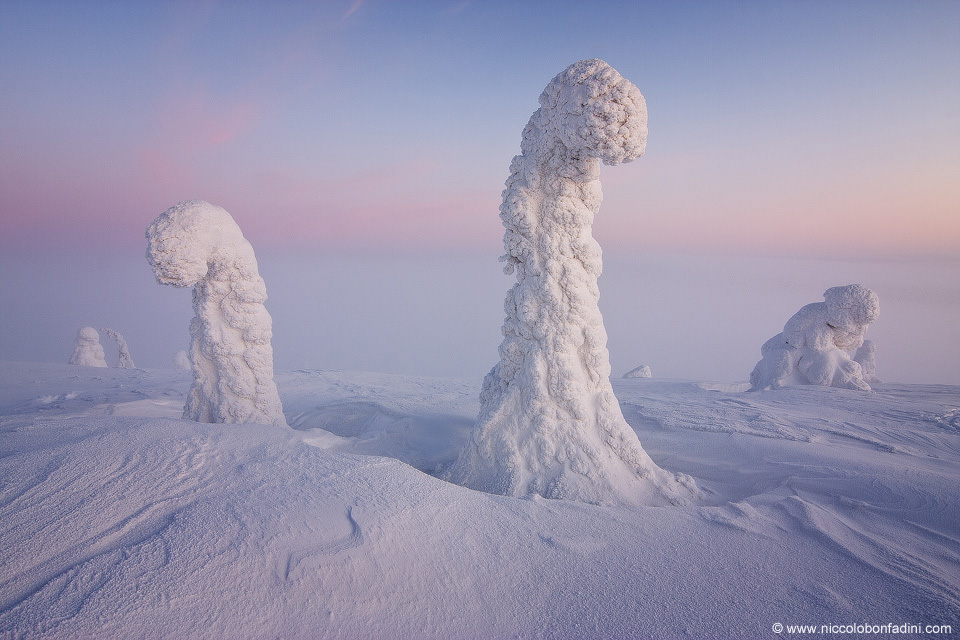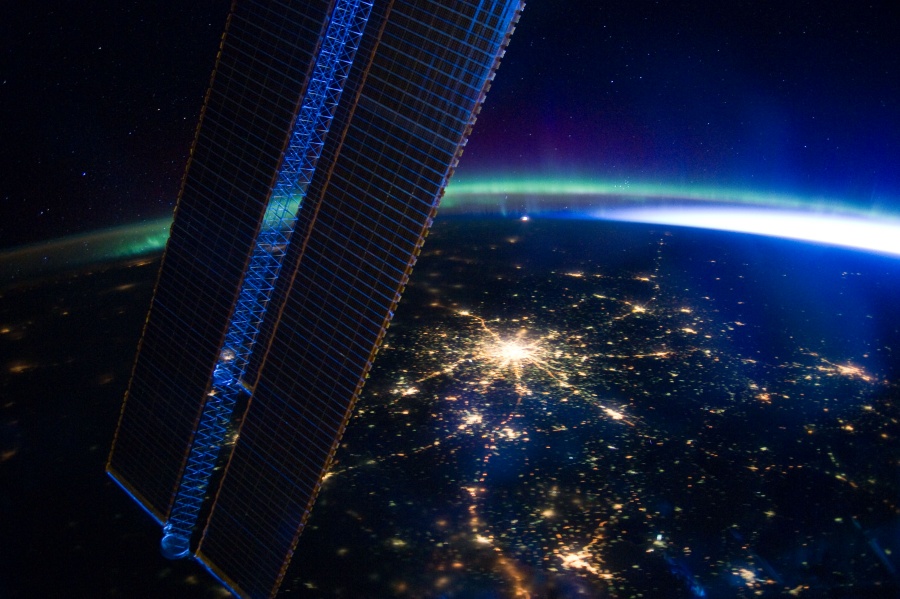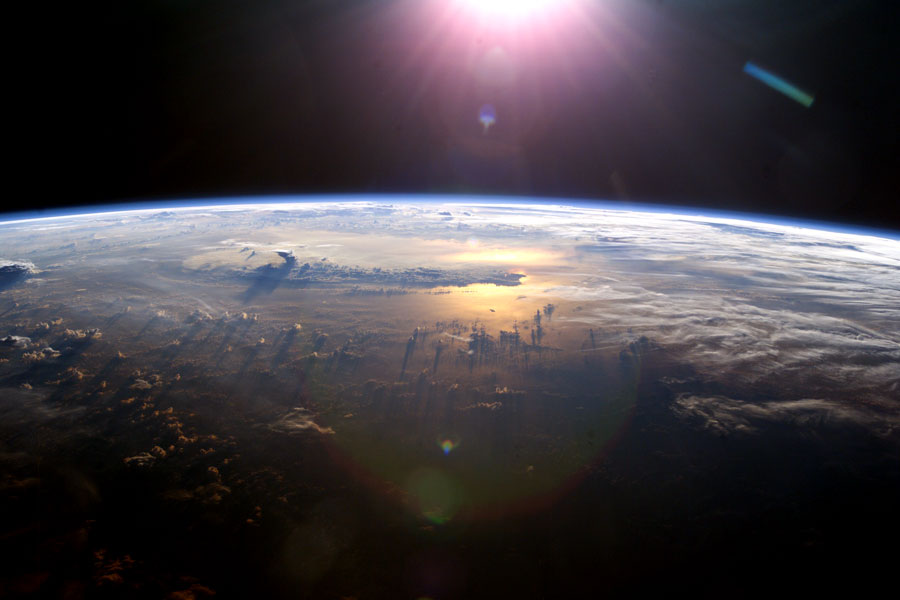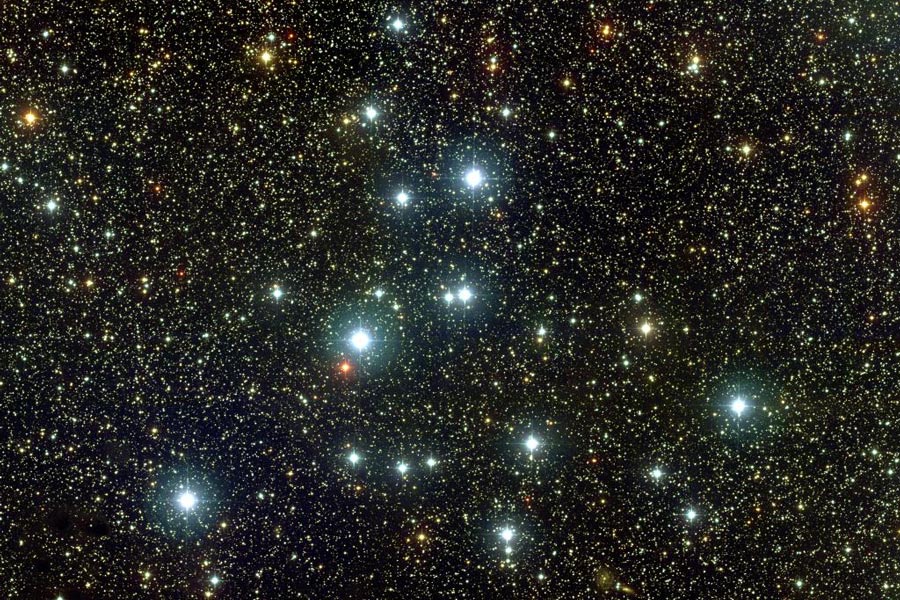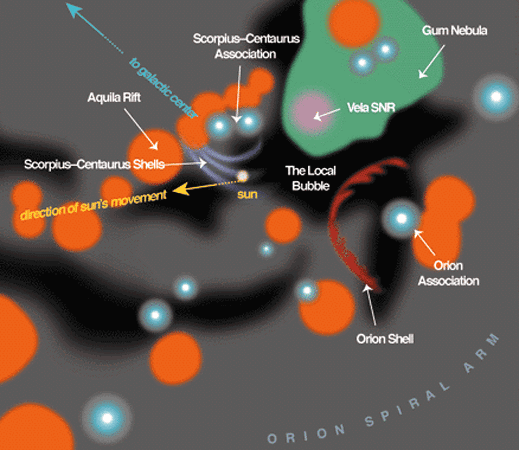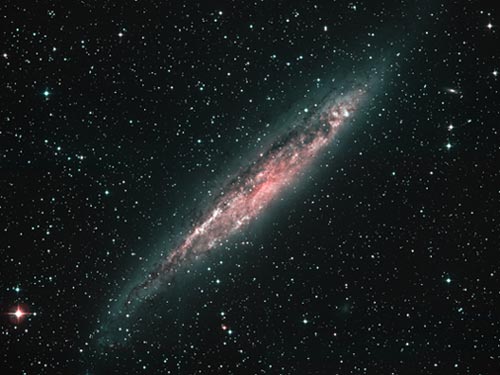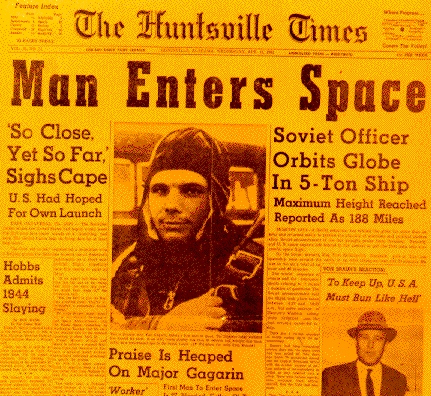| << Previous | Index | Next >> |
2015 Who guards the north? Judging from the above photograph, possibly giant trees covered in snow and ice. The featured picture was taken a few winters ago in Finnish Lapland where weather can include sub-freezing temperatures and driving snow. Surreal landscapes sometimes result, where common trees become cloaked in white and so appear, to some, as watchful aliens. Far in the distance, behind this uncommon Earthly vista, is a more common sight -- a Belt of Venus that divided a darkened from sunlit sky as the Sun rose behind the photographer. Of course, in the spring, the trees thaw and Lapland looks much different.
2014
[imghover6=http://apod.nasa.gov/apod/image/1404/HM ... ka1200.jpg]http://apod.nasa.gov/apod/image/1404/HM ... 0labV1.jpg[/imghover6]Image Credit & Copyright: Wally Pacholka (TWAN)
2013 On another April 12th, in 1961, Soviet cosmonaut Yuri Alexseyevich Gagarin became the first human to see planet Earth from space. Commenting on his view from orbit he reported, "The sky is very dark; the Earth is bluish. Everything is seen very clearly". On yet another April 12th, in 1981 NASA launched the first space shuttle. To celebrate in 2013, consider this image from the orbiting International Space Station, a stunning view of the planet at night from low Earth orbit. Constellations of lights connecting the densely populated cities along the Atlantic east coast of the United States are framed by two Russian spacecraft docked at the space station. Easy to recognize cities include New York City and Long Island at the right. From there, track toward the left for Philadelphia, Baltimore, and then Washington DC near picture center.
2012 On another April 12th, in 1961, Soviet cosmonaut Yuri Alexseyevich Gagarin became the first human to see planet Earth from space. Commenting on his view from orbit he reported, "The sky is very dark; the Earth is bluish. Everything is seen very clearly". To celebrate, consider this recent image from the orbiting International Space Station. A stunning view of the planet at night from an altitude of 240 miles, it was recorded on March 28. The lights of Moscow, Russia are near picture center and one of the station's solar panel arrays is on the left. Aurora and the glare of sunlight lie along the planet's gently curving horizon. Stars above the horizon include the compact Pleiades star cluster, immersed in the auroral glow.
2011 On April 12th, 1961, Soviet cosmonaut Yuri Alexseyevich Gagarin became the first human in space. His remotely controlled Vostok 1 spacecraft lofted him to an altitude of 200 miles and carried him once around planet Earth. Commenting on the first view from space he reported, "The sky is very dark; the Earth is bluish. Everything is seen very clearly". His view could have resembled this image taken in 2003 from the International Space Station. Alan Shepard, the first US astronaut, would not be launched until almost a month later and then on a comparatively short suborbital flight. Born on March 9, 1934, Gagarin was a military pilot before being chosen for the first group of cosmonauts in 1960. As a result of his historic flight he became an international hero and legend. Killed when his MIG jet crashed during a training flight in 1968, Gagarin was given a hero's funeral, his ashes interred in the Kremlin Wall. Twenty years later, on yet another April 12th, in 1981, NASA launched the first space shuttle.
2010
[imghover6=http://apod.nasa.gov/apod/image/1004/me ... esmars.jpg]http://apod.nasa.gov/apod/image/1004/me ... otated.jpg[/imghover6]Credit & Copyright: Josselin Desmars
2009 Lying just at the limit of human perception is a picturesque starfield containing one of the larger open clusters on the northern sky. Spanning an angle larger than the Moon, M39's relatively few stars lie only about 800 light years distant toward the constellation of Cygnus. The above picture of M39 is a mosaic of 33 images taken by the WIYN telescope on Kitt Peak in Arizona, USA. The stars in M39 are all about 300 million years old, much younger than the 5,000 million years of our Sun. Open clusters, also called galactic clusters, contain fewer and younger stars than globular clusters. Also unlike globular clusters, open clusters are generally confined to the plane of our Galaxy.
2008
2007 Cosmic clouds of hydrogen gas and dust abound in this gorgeous skyscape, stretching through Monoceros in the neighborhood of The Cone Nebula. A dark, obscuring dust cloud, the simple, sculpted shape of the Cone Nebula is near the lower left edge. Surrounded by the red glow of hydrogen gas, the cone points up, toward bright, blue-white S Monocerotis, a quadruple system of very massive, hot stars. S Mon itself is also surrounded by intriguing red emission nebulae characteristic of star forming regions while above and to the right of S Mon, expansive dark markings on the sky are silhouetted by a larger region of fainter emission. Yellowish open star cluster Trumpler 5 is below picture center, with the striking blue reflection nebula, IC 2169 near the center right edge. The curious compact cometary shape near the bottom edge is Hubble's Variable Nebula. Over 31 hours of exposure time went into this truly remarkable, 2.5 degree wide, color mosaic.
2006 The two bright sources at the center of this composite x-ray (blue)/ radio (pink) image are co-orbiting supermassive black holes powering the giant radio source 3C 75. Surrounded by multimillion degree x-ray emitting gas, and blasting out jets of relativistic particles the supermassive black holes are separated by 25,000 light-years. At the cores of two merging galaxies in the Abell 400 galaxy cluster they are some 300 million light-years away. Astronomers conclude that these two supermassive black holes are bound together by gravity in a binary system in part because the jets' consistent swept back appearance is most likely due to their common motion as they speed through the hot cluster gas at 1200 kilometers per second. Such spectacular cosmic mergers are thought to be common in crowded galaxy cluster environments in the distant universe. In their final stages the mergers are expected to be intense sources of gravitational waves.
2005
2004 What would it be like to explore the surface of another world? In 1972 during the Apollo 17 mission, astronaut Harrison Schmitt found out first hand. In this case, the world was Earth's own Moon. In this recently compiled panorama of lunar photographs originally taken by astronaut Eugene Cernan, the magnificent desolation of the barren Moon is apparent. Visible above and by scrolling right are lunar rocks in the foreground, lunar mountains in the background, some small craters, a lunar rover, and astronaut Schmidt on his way back to the rover. A few days after this image was taken, humanity left the Moon and has yet to return.
2003 Have you ever seen the planet Mercury? Because Mercury orbits so close to the Sun, it never wanders far from the Sun in Earth's sky. If trailing the Sun, Mercury will be visible low on the horizon for only a short while after sunset. If leading the Sun, Mercury will be visible only shortly before sunrise. So at certain times of the year an informed skygazer with a little determination can usually pick Mercury out from a site with an unobscured horizon. Above, a lot of determination has been combined with a little digital trickery to show Mercury's successive positions during March of 2000. Each picture was taken from the same location in Spain when the Sun itself was 10 degrees below the horizon and superposed on the single most photogenic sunset. By the middle of this month, Mercury will again be well placed for viewing above the western horizon at sunset, but by the end of April it will have faded and dropped into the twilight. On May 7th, Mercury will cross the Sun's disk.
2002 This gorgeous galaxy and comet portrait was recorded on April 5th in the skies over the Oriental Pyrenees near Figueres, Spain. From a site above 1,100 meters, astrophotographer Juan Carlos Casado used a guided time exposure, fast film, and a telephoto lens to capture the predicted conjunction of the bright Comet Ikeya-Zhang (right) and the Andromeda Galaxy (left). This stunning celestial scene would also have been a rewarding one for the influential 18th century comet hunter Charles Messier. While Messier scanned French skies for comets, he carefully cataloged positions of things which were fuzzy and comet-like in appearance but did not move against the background stars and so were definitely not comets. The Andromeda Galaxy, also known as M31, is the 31st object in his famous not-a-comet catalog. Not-a-comet object number 110, a late addition to Messier's catalog, is one of Andromeda's small satellite galaxies, and can be seen here just below M31. Our modern understanding holds that the Andromeda galaxy is a large spiral galaxy some 2 million light-years distant. The photogenic Comet Ikeya-Zhang, now a lovely sight in early morning skies, is about 80 million kilometers (4 light-minutes) from planet Earth.
2001 On April 12, 1981, twenty years ago today, the space shuttle orbiter Columbia became the first shuttle to orbit the Earth. In this gorgeous time exposure, flood lights play on the Columbia and service structures (left) as it rests atop Complex 39's Pad A at Kennedy Space Center in preparation for first launch. Flown by Commander John W. Young and Pilot Robert L. Crippen, Columbia spent 2 days aloft on its check-out mission, STS-1, which ended in a smooth landing, airplane-style, at Edwards Air Force Base in California. Ferried back to Kennedy by a modified Boeing 747, Columbia was launched again seven months later on STS-2, becoming the first piloted reuseable orbiter. The oldest operating shuttle orbiter, Columbia's 1981 debut was followed by Challenger in 1982 (destroyed in 1986), Discovery in 1983, Atlantis in 1985, and Challenger's replacement Endeavour in 1991. This shuttle orbiter fleet has now accomplished over 100 orbital missions. Today also marks the 40th anniversary of the first human in space, Yuri Gagarin.
2000 What surrounds the Sun in this neck of the Milky Way Galaxy? Our current best guess is depicted in the above map of the surrounding 1500 light years constructed from various observations and deductions. Currently, the Sun is passing through a Local Interstellar Cloud (LIC), shown in violet, which is flowing away from the Scorpius-Centaurus Association of young stars. The LIC resides in a low-density hole in the interstellar medium (ISM) called the Local Bubble, shown in black. Nearby, high-density molecular clouds including the Aquila Rift surround star forming regions, each shown in orange. The Gum Nebula, shown in green, is a region of hot ionized hydrogen gas. Inside the Gum Nebula is the Vela Supernova Remnant, shown in pink, which is expanding to create fragmented shells of material like the LIC. Future observations should help astronomers discern more about the local Galactic Neighborhood and how it might have affected Earth's past climate.
1999 For such a close galaxy, NGC 4945 is easy to miss. NGC 4945 is a spiral galaxy in the Centaurus Group of galaxies, located only six times farther away than the prominent Andromeda Galaxy. The thin disk galaxy is oriented nearly edge-on, however, and shrouded in dark dust. Therefore galaxy-gazers searching the southern constellation of Centaurus need a telescope to see it. The above picture was taken with a large telescope testing a new wide-angle, high-resolution CCD camera. Most of the spots scattered about the frame are foreground stars in our own Galaxy, but some spots are globular clusters orbiting the distant galaxy. NGC 4945 is thought to be quite similar to our own Milky Way Galaxy. X-ray observations reveal, however, that NGC 4945 has an unusual, energetic, Seyfert 2 nucleus that might house a large black hole.
1998 Newborn stars are forming in the Eagle Nebula. This image, taken with the Hubble Space Telescope in 1995, shows evaporating gaseous globules (EGGs) emerging from pillars of molecular hydrogen gas and dust. The giant pillars are light years in length and are so dense that interior gas contracts gravitationally to form stars. At each pillars' end, the intense radiation of bright young stars causes low density material to boil away, leaving stellar nurseries of dense EGGs exposed. The Eagle Nebula, associated with the open star cluster M16, lies about 7000 light years away.
1997 The Arecibo radio telescope is currently the largest single-dish telescope in the world. First opening in 1963, this 305 meter (1000 foot) radio telescope resides in a natural valley of Puerto Rico. The Arecibo telescope has been used for many astronomical research projects, including searches and studies of pulsars, and mapping atomic and molecular gas in the Galaxy and the universe. As the Arecibo dish can also be used to send radio waves, it has bounced and recorded radiation off of planets in our Solar System, and has even broadcast messages to areas of the Galaxy that might contain intelligent extra-terrestrial life. Any person in the world may use the telescope, providing their proposal is selected by a review committee.
1996 Thirty five years ago today, Soviet cosmonaut Yuri Alexseyevich Gagarin became the first human in space. On April 12, 1961, his remotely controlled Vostok 1 spacecraft lofted him to an altitude of 200 miles and carried him once around planet Earth. Strictly a passenger, his onboard controls were locked out by a secret combination - in case of emergency he carried the combination in a sealed envelope. After reentry, Gagarin ejected from the Vostok at an altitude of 20,000 feet and parachuted to Earth. How was the first view from space? He reportedly commented, "The sky is very dark; the Earth is bluish. Everything is seen very clearly". Coupled with other spacefaring accomplishments, this flight seemed to confirm Soviet technological superiority - the first US astronaut would not be launched until almost a month later and then on a comparatively short suborbital flight. Born on March 9, 1934, Gagarin was an air force jet pilot before being chosen for the first group of cosmonauts in 1960. As a result of his historic flight he became an international hero and legend. Killed when his MIG jet crashed during a training flight on March 27, 1968, Gagarin was given a hero's funeral, his ashes interred in the Kremlin Wall.
| << Previous | Index | Next >> |
